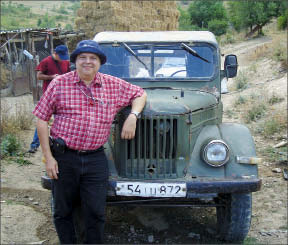Montreal-based Caldera Resources (CDR-V) has a busy season ahead of it at the Marjan gold-silver project in Armenia, as it confirms and upgrades the project’s historical resources.
The property is 30 km southwest of the village of Sisian in Armenia’s southern Syunik province, which also hosts Dundee Precious Metals‘ (DPM-T) Kapan polymetallic mine and Lydian International‘s (LYD-T) Amulsar gold project.
“The Soviet-era Armenian geophysicist that did the work was of very high quality,” and the past exploration produced a ”mountain of data,” Caldera CEO Bill Mavridis said during an interview in Toronto.
Marjan’s Central zone has Soviet-era C1 and C2 resources totaling 4.7 million tonnes of 2.64 grams gold per tonne and 92.67 grams silver per tonne for 405,000 oz. gold and 14.2 million oz. silver. Under the historical P1 category it has 3.2 million tonnes of 2.35 grams gold and 93.42 grams silver for 242,000 oz. gold and 9.6 million oz. silver.
The North zone holds an additional 5.7 million tonne P1 resource grading 2.18 grams gold and 148.46 grams silver for 404,000 oz. gold and 27.5 million oz. silver.
Soviet-era C1 and C2 resources are equivalent to indicated and inferred resources, respectively, according to the Committee for Mineral Reserves International Reporting Standards. P1 resources are also considered inferred.
“Everything to date is showing that the Soviet model has validity,” Mavridis said. The results from trenching and 2,800 metres of drilling completed late last year back up the historical numbers, he added.
Marjan hosts an outcropping gold-silver-lead-zinc-copper vein system with both epithermal and mesothermal characteristics. The resource is associated with a hydrothermal alteration profile including clay, sericite, and silica- pyrite alteration phases.
The project also has a “special mining licence” which expires in 2033, similar to the one under which Dundee operates.
Marjan’s main targets, the Central and North zones, are about 2 km apart with veins running north-south. “There seems to be the same vein system in the Central area, all the way to the North, and there is a gap of information between the two centres,” Mavridis said. “So the possibility to expand this resource is enormous.” Past exploration did not probe below 250 metres and the targets remain open at strike and depth, he added.
The company has also identified a third target, the Clastic Unit, which it describes as conglomeratic sandstone that unconformably overlaps the Marjan North vein zones on the southern boundary.
Caldera geologist Ricardo Valls is especially excited about the “blue sky potential” of the Clastic Unit. He said geochemical soil sampling of the area shows copper-zinc-silver mineralization disseminated with a clear east-west orientation. The mineralization appears to be the result of the erosion of a previously existing mineralized zone, which was redeposited within the Clastic Unit, he said.
The geochemical signature from the soil sampling shows the existence of north-south trending gold and lead anomalies, similar to the gold-lead anomalies mapped in the quartz veins on the property, Valls said.
Caldera believes that apart from the disseminated copper-zinc-silver mineralization, there are zones of enrichment of gold and lead, associated with the intrusion of these quartz veins into the Clastic Unit.
In April Caldera released results from the 14 holes drilled in the Central zone, including hole 5 which yielded 451 grams silver per tonne, 1.3 grams gold per tonne, 8% lead and zinc over 2 metres, and hole 8 with 2.6 grams gold, 164 grams silver, 0.13% copper and 9% lead and zinc over 7 metres. Results are pending from the two holes drilled in the Clastic Unit.
Trenching and chip sampling have also yielded high grades in the alteration zones between the veins, areas ignored by the Soviet exploration, which increases Marjan’s potential, Valls said.
Caldera plans to complete more mapping and surveying in June, followed by trenching in the North zone throughout the third quarter, with 3,000 metres of drilling starting in the fourth quarter, likely to focus on the Central zone.
“We want to have a better understanding of the Soviet data, and then we’ll have a proper plan to start drilling the whole system,” Mavridis said.
Caldera acquired 55% of Marjan through a joint-venture agreement with Rye, New York-based Global Gold (GBGD-O), under which Caldera is obligated to buy the project outright for about US$3 million by the end of 2012. “It’s really a purchase agreement wrapped around a joint-venture,” Mavridis said.
However, the relationship between the two companies has soured since October, when Global announced its intention
to terminate the agreement, alleging Caldera violated the terms of the contract.
Caldera has filed for binding arbitration. A preliminary hearing is scheduled for June 13 in New York to set the arbitration date.
In Global’s filings it alleges Caldera has failed to fulfill obligations under the JV, both financially and related to maintaining the mining licence, and illegally transferred shares to the JV company. Global CEO Van Krikorian declined to comment on the record about the dispute.
Mavridis said Global’s move to terminate the agreement came shortly after the first of two notices were issued from the Armenian Ministry of Energy and Natural Resources (MENR) regarding Marjan’s mining licence. The MENR has since annulled the notices and affirms that the mining licence is in good standing.
Mavridis said Global’s allegations are baseless and that the company is suffering from a case of seller’s remorse. He maintains Caldera has complied with the terms of the agreement, financial and otherwise, and is poised to own the project outright, in accordance with the original agreement.
“It’s a simple interpretation of contract law. All the facts support our claims. . . Everything should be settled this year,” Mavridis said.
At presstime Caldera shares were trading at 9¢, with a 52 week range of 7.5¢-25.5¢ and 56.6 million shares outstanding.


Be the first to comment on "Caldera focuses on Marjan in Armenia (June 13, 2011)"